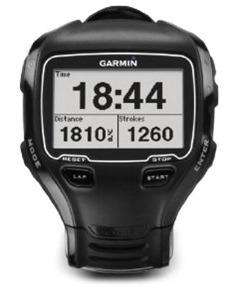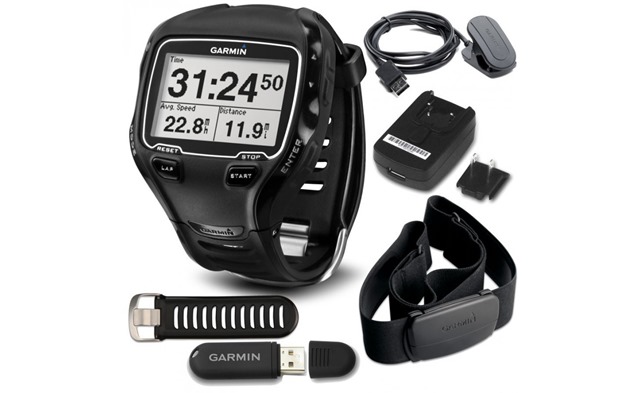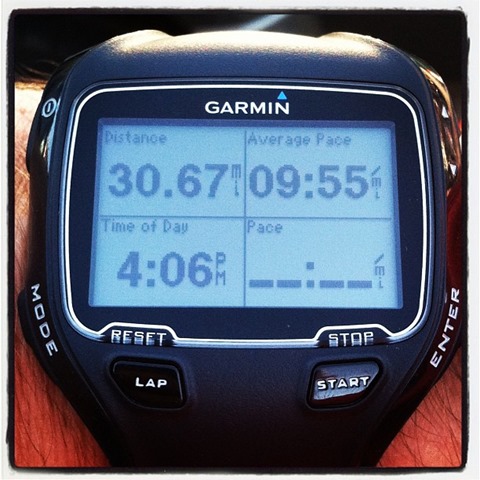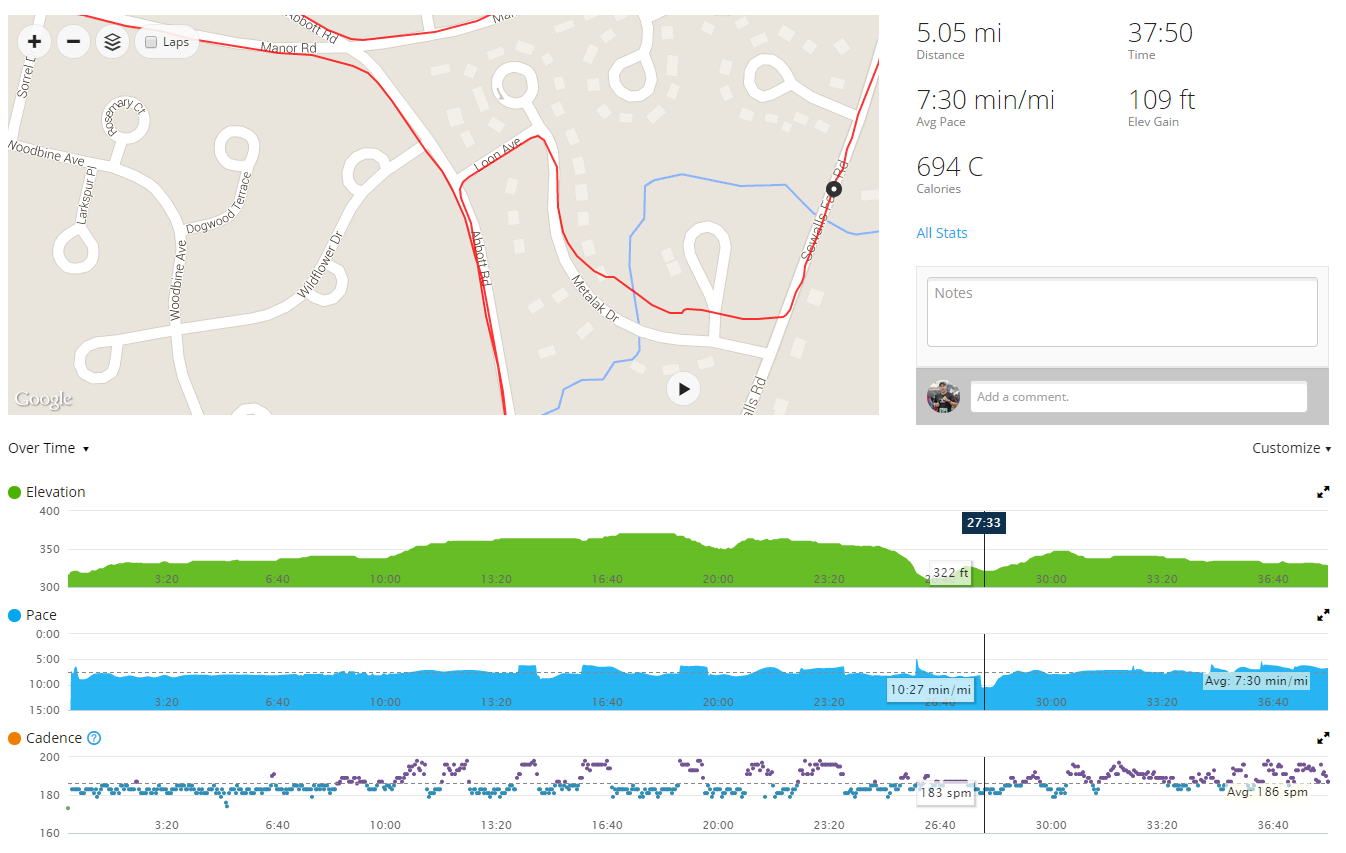 My first ever GPS watch was the Garmin Forerunner 205. I loved that watch and used it on every run for several years. It was rock-solid when it came to tracking, the battery seemed to last forever, and it carried me through multiple marathons without issue.
My first ever GPS watch was the Garmin Forerunner 205. I loved that watch and used it on every run for several years. It was rock-solid when it came to tracking, the battery seemed to last forever, and it carried me through multiple marathons without issue.
My only real issue with the 205 was that it was big. Too big to wear as an all-day watch. The nuisance of having to swap watches for runs prompted me to buy the smaller Garmin 610 a bit over a year ago (I’ve since sold the 610 and now have a Garmin 620).
Over the past few years Garmin has released out a few successors to the 205/305. First came the 310XT (still available, under $200 at Clever Training). The 310XT was marketed as a triathlon/multisport watch – it boasted ~20 hrs of battery life, easy swapping between wrist and bike mount, and a waterproof housing that could be worn while swimming. The 310XT was followed by the Garmin Forerunner 910XT, which maintains the big battery life (also ~20 hours) and waterproof housing, but adds additional bike and swim tracking features.
Clever Training sent me a sample of the Garmin Forerunner 910XT to try out (it was a loaner and will be returned to them after this is published). I’m going to keep this review short because I’m not a triathlete – I have not used any of the bike or swim oriented features (check out DC Rainmaker’s 910 XT review for more on these aspects of the device). My comments below are geared toward the runner who might be interested in this watch.
After spending some time with the 910XT I’ve concluded that for a runner, this watch is pretty similar to the old 205/305. It’s a bit bulky – slimmer than the 205/305, but still not an all-day watch. It has a big, easy to read screen that allows up to 4 data fields and a ton of field customization options. And it’s rock-solid when it comes to recording accuracy. All are things I loved about the 205.
I loaned the 910XT to my buddy Brett to use in the VT50K last Fall, and as an example of recording accuracy here was the result:
Only one-third of a mile short over 31 trail miles is pretty darned solid (~99% accurate).
Where the 910XT improves on the 205/305 (I never tried the 310XT) is with its multisport/triathlon features (again, read DC Rainmaker’s review for more on these, he evaluates them far better than I could) and the fact that it doubles the battery life. It also connects to satellites a bit faster, which is nice.
The big question for a runner is: “Do I really need a bulky, $399 GPS watch?”
My answer would be maybe. It really depends on what your needs are.
Battery life is the major (only?) reason why some runners might need a watch like the 910XT. For example, ultrarunners would benefit from a battery that lasts well over 10 hours. The 910XT should cover most people up to 50 miles, and might even work for particularly fast 100 mile racers like my buddy Nate who ran sub 20:00 at Vermont 100 last year. There aren’t a lot of other options for GPS watches with big battery life – others that I’m aware of that run 20+ hrs are the $500 Suunto Ambit2 and the Garmin Fenix (which DC Rainmaker did not review glowingly for runners; the Fenix 2 is coming later this month, but don’t know much about it). The other potentially appealing feature of the 910XT for ultrarunners is the barometric altimeter, which should record elevation data more accurately than other watches.
The other two situations I could see where this watch would be a good fit would be for a runner who also does a lot of hiking and wants to track that as well, or for a runner who might want to keep a door open for triathlons in the future. In most other cases a cheaper, smaller watch should suffice.
Conclusion
The Garmin Forerunner 910XT is a power-packed watch targeted at multisport athletes. It’s probably more watch than is necessary for most runners, however, super long battery life sets it apart from most other GPS running watches. If you need a big battery, the 910XT would be an excellent choice.
Garmin Forerunner 910XT Purchasing Options
 The Garmin Forerunner 910XT is available for purchase at Clever Training. Clever Training specializes in fitness electronics, and has agreed to provide a 10% off discount to Runblogger readers on most products that they carry – just enter the code RunBlogXJT at checkout.
The Garmin Forerunner 910XT is available for purchase at Clever Training. Clever Training specializes in fitness electronics, and has agreed to provide a 10% off discount to Runblogger readers on most products that they carry – just enter the code RunBlogXJT at checkout.
Purchases made at Clever Training support this site and help me to write reviews like this one. Your support is very much appreciated!





















Peter – You should definately look at the 620 instead. It’s a real running watch, and could be interesting for you when you analyse gait or problems in running posturewise. – Its not going to substitute a professional solution, but the batterytimes should be quite close and it has quite a few running specific things. – Again as you say yourself – Ray Maker does a damn good job at describing it all so please read his review.
I have the 620, but have been so smitten with my Magellan Echo that I haven’t played with it enough. It’s the next GPS review on my list. It’s tough to compete with Ray on GPS reviews, he’s the best, so I aim for more concise :) I geek out more on shoes.
I have heard of GPS accuracy problems with the 620 and it is confirmed in this very detailed review/comparo of GPS accuracy on this site: link to fellrnr.com
I did a little looking on the Garmin 620 forums and confirmed this is a pretty big issue that people are running into with the 620. I guess when my 610 dies, I may look elsewhere. I am currently considering the TomTom Runner, based on some very positive reviews I have read about it.
Brad. Thanks for posting that link. The results make the 620 GPS capabilities look woefully inadequate compared to other models. I have a 620, and have had some issues with accuracy (particularly on a 400M track). I did some digging today, and I’m wondering if the inaccuracy is due to the “Smart” data recording setting–where, if I understand correctly, the watch samples at a low rate (~6 seconds between samples) but increases when there is a change in direction/pace/heart rate. There is a “Every Second” data sample setting. I’m going to try out the “Every Second” setting on my next track workout to see if that makes a difference. In the article you linked to, I didn’t see whether the authors compared across these two settings. Might be worth finding out.
This topic might also be fodder for your upcoming review of the 620, Peter.
I plan to look at this. FWIW, DC Rainmaker has not reported issues with accuracy on his unit, and in comments on his site seems to suggest that it may be an issue with a subset of units.
Just put up a post on accuracy in the 620: link to runblogger.com
Short answer, I have seen some strange recordings, but only on about 10% of my runs.
The form factor makes it look and feel slimmer than it really is. Just slightly thinner than the 305, but looks a lot thinner.
Also there may be old reviews out there about the poor performance of the altimeter, but firmware updates have improved it dramatically. I will go on looped trail runs and it may be only off by 15-20 feet at the end. Early on it would have been a couple of hundred.
This watch is going on 2 years old by now. Why review something which everyone who has been using it for awhile is hoping for an update soon?
Because reviews are generally for people who do not already have the device. Best time for reviews is when a product is new, or when a price drop is about to occur because a product is being replaced. Haven’t heard about a replacement for the 910XT, but I suspect it’s due, though I have read not to expect anything this year.
does anyone have any tips for keeping the hrm strap in place when running with a backpaack on. I run to work, and about 20 meters from my front door the strap has been jolted down by the bag, and I’m trying to measure the pulse of my belly.
Pete, I own one of these and after a very short flirtation with triathlons, it is a “mostly” running only watch that I have come to depend on. As a more mature (older) runner, the large face is very helpful and I also like that it has buttons so I don’t accidently change/stop/start something like I did with the old touch watches.
The large screen is definitely a plus, loved that about the 205 as well. Nowadays prefer not swapping watches though so there are tradeoffs. Won’t be long before we have screens the size of 910XT in thin form factors I suspect.
I have this watch, and only bought it because they lowered the price to around $200 around the time the 620 came out. I have been pretty happy with it, especially the battery. I only charge it about once per week with running 40-50 miles. I still like the accuracy of my 305 the best. I have had problems with the heart rate chest strap, as I haven’t been able to wear it without major chafing, no matter how I adjust it. Anyone else have a solution to this? I have thought about putting a piece of foam mousepad behind it to fill in the space between it and my bony chest….
Gotta chime in on the 910xt. As a triathlete, it’s basically indispensable and there aren’t really any other options for a swim/bike/run GPS. That being said, it’s been plagued by elevation problems. TONS of forums clogged with reports of elevation readings off by 60,000 feet, most likely caused by faulty barometers. To their credit, Garmin has been really responsive and has been quick to fix or replace, even if out of warranty. I’m on my second unit after an elevation issue and am in the process of returning that unit for the same issue. It will be my third one in less than two years. Not the kind of durability you’d hope to see in a product that runs $400-$500.
Hello, I wonder if maybe you know how much the battery life changes after you have used the clock a while, maybe a year? From the beginning it says up to 20 hours, maybe this won´t be true after using it. I am thinking about buying a used one but I really want the battery to be able to at least last the ironman time, well maybe maxiumum 15 hours or so. What do you think?
Regards Daniel